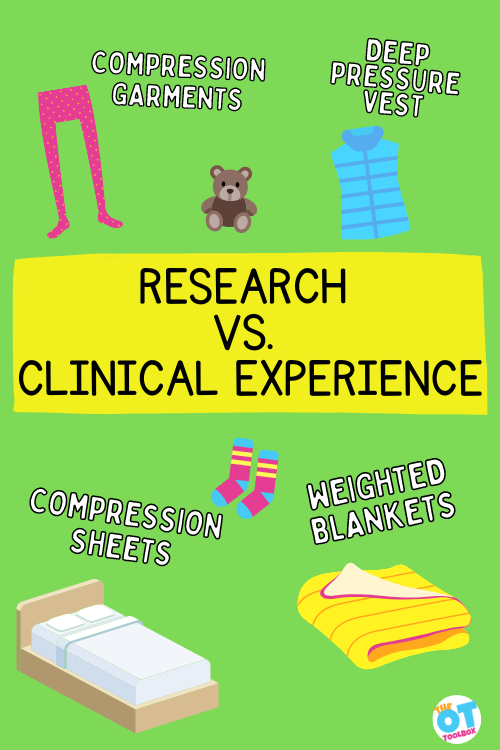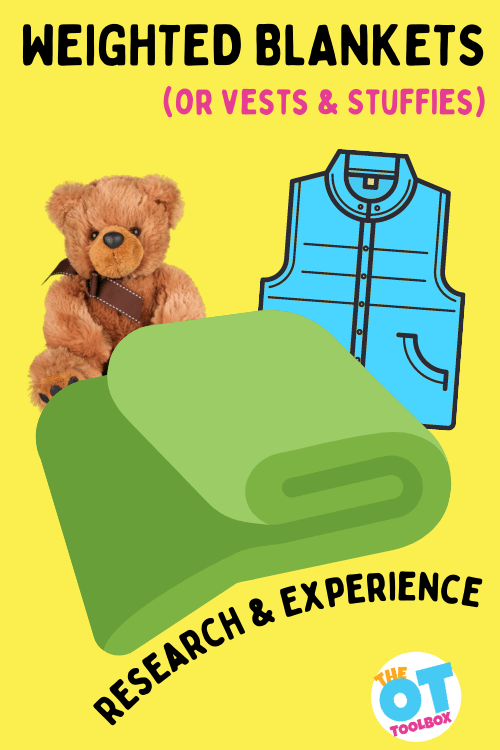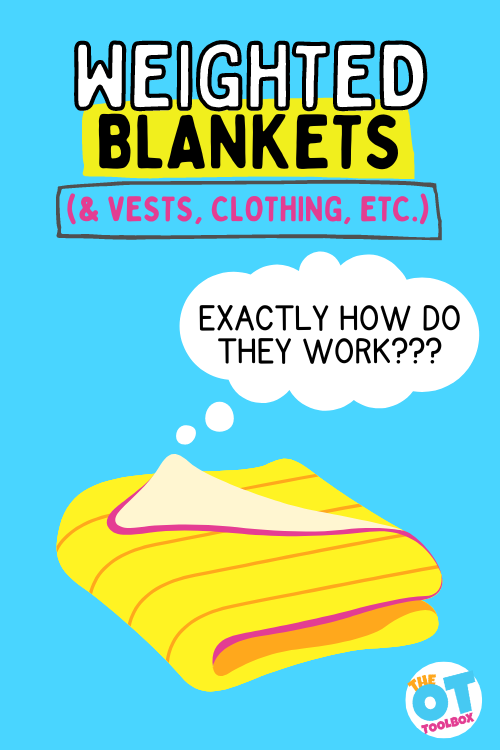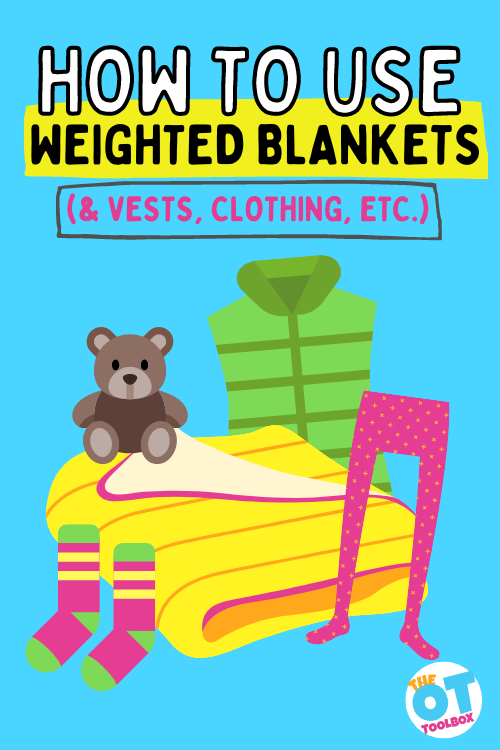Weighted vests, weighted clothing, and compression garments are used to offer proprioceptive input to elicit a calm and focused response. They tend to be used as a sensory intervention for children with diagnoses like sensory processing disorder, autism (ASD) and attention deficit hyperactivity disorder (ADHD), with the purpose of calming the body for functional activities.
Weighted vests are a hot topic in the therapy world, as they have been used in practice for decades. Sensory strategies are difficult to research, gather data, or prove their efficacy. Want to learn more about sensory processing disorder? Use this checklist to guide you!

Weighted clothing Research review versus clinical observation
This article will dive into the research versus clinical observation, on the use of weighted vests and compression clothing. Here at The OT Toolbox team, we’re lucky to have therapists with a variety of experiences, and years in the field. This blog post on weighted clothing, weighted blankets, and other weighted sensory tools explores both clinical experience and evidence for a combined viewpoint.
We’re covering both here: what the research says about weighted clothing and what clinical experience and data says about these weighted tools.
The first author, Sydney Thorson OTR/L is a school based therapist who bases her practice on research and evidence based practice. The second author, Victoria Wood OTR/L is an occupational therapist with 30 years of clinical experience, who bases her treatment on clinical observation, data collection, and real life experience.

Research on weighted vests and Compression Vests
(Research review by Sydney Thorson OTR/L)
Weighted vests have been used in clinical practice for many years, without strong research evidence they actually work. In my opinion, this is a big deal for our field, as we should not be implementing such tools without good reason. If you’ve ever had questions about best practice and research on weighted vests, compression clothing, and weighted compression vests, read on.
A note about Research on Weighted Clothing, Weighted Vests and Compression Garments
If you are looking to purchase a vest or implement it into therapy, there is not much data available online, or in popular pediatric therapy books. Some features of the vests may be noted in research articles. Important factors such as the amount of weight to be used, the length of time it should be donned, or the frequency of use is never suggested. Why? Because we simply do not have any data to support this yet.
Most importantly, occupational therapists are often providing treatment under the Individuals With Disabilities Education Act, which mandates therapeutic and instructional strategies must be research-based whenever possible.
How Do I Know Which Research to Trust?
One of the most difficult parts of a literature review is understanding how likely it is that the study results are actually “true”, and therefore, clinically significant. In my review below, I have noted how strong the level of evidence, so that you can decide how best to use the information moving forward.
What does it mean to be clinically significant?
Statistical significance is what tells researchers if their chosen effect really happened or not. A researcher may determine that a weighted vest has a statistically significant effect based on their data from a research environment. In real-life practice, it may not have the same results.
The clinical significance is just another way to say, “does this treatment actually work for my patients in their normal environment?”
All good literature reviews start a question that needs to be answered:Do weighted or compression vests improve regulation in children with disabilities?
In my opinion, the simple answer is…probably not.
Best Evidence for Weighted Vests
A systematic review is generally the best way to learn about a research topic. Researchers thoughtfully and methodically take into account numerous studies, compiling the results into one article, for the reader to enjoy.
One of the more recent systematic reviews, titled, “Systematic Review on the Efficacy of Weight Vests and Blankets for People with ASD or ADHD” noted that earlier reviews found that these items did not have efficacy (Denny et al., 2018). Since then, data continues to show inconsistent effectiveness of weighted vests.
This review included 18 studies, four of which were also systematic reviews. The efficacy of each study in this review was noted and used to offer the following results;
Results (Denny et al., 2018)
- In individuals with ASD or ADHD:
- Moderate evidence suggests that weighted items can increase attention and occupational performance.
- Mild evidence supports that weighted items can reduce maladaptive behaviors, like aggression, self-injurious behaviors, or off-task behaviors.
- No evidence supports the use of weighted items to increase adaptive behaviors, like seated, on-task behavior.
- More rigorous studies are needed to determine if weighted items actually produce a clinically significant effect.
- Use weighted items cautiously to determine if they will provide positive outcomes.
Should Occupational Therapists Use Weighted Vests?
In my opinion, with the inconsistent and insufficient available evidence of an intervention that is broadly used, OTs should turn to the leaders for guidance. This would include the American Occupational Therapy Association (AOTA). The American Journal of Occupation Therapy (AJOT) provided two systematic reviews on the topic of sensory interventions in 2020.
One review reported that weighted vests are not effective in increasing educational performance in children with ASD (Grajo, Candler & Sarafian, 2020).
The other systematic review from the AJOT went even further and stated that “weighted vests/items…received a red light designation…indicating that therapists should not use these approaches for children with sensory processing challenges” (Battin et al., 2020).
Best Evidence for Weighted Compression Vests
Compression vests are currently less likely to have specific data on their use, as they are often used a part of a treatment plan, either with weighted vests or other sensory items. Weighted vests are far more popularized in the research arena, but below you will find the best available evidence for compression vests.
A meta-analysis (including a systematic review) that complied recent data for deep pressure therapy items, including weighted and compression vests, squeeze machines, and brushing therapy, found that none were supported by evidence for any reason (Losinski, Sanders & Wiseman, 2017). Many of the studies reported on were low-quality for a number of reasons, and it is unknown how this could contribute to the results.
Weighted Vests and Autism
Occupational therapists often support individuals on the autism spectrum in the classroom, home, community, and clinic. OTs work closely in early intervention services with individuals diagnosed with autism.
While there are benefits for using weighted vests with individuals on the autism spectrum, in my opinion, it’s important to discern, through a research review, whether the specific needs of the individual are addressed.
A weighted vest, weighted clothing, compression clothing, compression bed sheets, or weighted blanket are just some of the tools used to support individuals with autism.
The benefit suggested of a weighted device or compression material refers to the regulation of the central nervous system, and the physical input through the proprioceptive system. This input can impact sleep, temperature regulation, to organize and calm the nervous system. It’s easy to see the connection between the nervous system, regulation of the individual, and functional performance of tasks.
Another great resource is the use of sensory clothing, or clothing that supports sensory needs, no matter the diagnoses or preference. In recent years, there are more options out there as well as greater availability to accessing sensory-friendly garments.
Should Occupational Therapists Use Compression Vests?
Unsurprisingly, there is limited guidance from our OT leaders at AOTA and AJOT that is specific to compression vests. This means that therapists can wait for guidance to come out, conduct their own research to add to the mix, or follow their next best available guidance. My gut tells me to follow the guidelines from AJOT for weighted vests, noted above.
This data trend is not exclusive to vests – some recent data does not support implementing any single-system sensory intervention in the school environment. Single-system sensory interventions, like swings, vests, and brushing, are becoming increasingly unsupported by leaders in occupational therapy (Grajo et al, 2020; Novak, 2019; Bodison, 2018; Wong et al, 2014; Watling, 2015).
This data does not make any statement towards other “sensory” experiences that are play-based, functional, or explorative in nature.
Research on the use of sensory-based interventions presented in the AJOT in 2018 suggested that many OTs “continued to use primarily clinical experiences and knowledge from their professional education programs rather than formal evaluations or scientific literature” (Carter & Glennon, 2018). The authors (and I) recommend a shift in our practice to utilize research evidence over personal experiences.
Clinical observation, data collection, real life experience on the benefit of weighted vests and compression tools
(Clinical experience by Victoria Wood, OTR/L)
The other side of the coin is a conflicting opinion, but one that therapists who have seen the benefits of weighted clothing and compression garments at work.

How a weighted vest works
Sensory seekers need to have their sensory “cup” filled in order to feel satiated. Have you ever wondered why a child with hyperactivity would be prescribed a stimulant?
The simple answer is; they will continue to seek input until their cup is full.
The stimulant, such as Ritalin, fills their cup faster than other sensory input. Once the cup is full, the person seeking input feels satiated, and can focus on work, functional tasks, or social skills. It is similar to needing to eat until you are full.
In a recent article on relaxation breathing, we covered how the autonomic nervous system responds to stimulation that is perceived as dangerous, over-simulating, or anxiety inducing via the commonly referred to signs of “fight, flight, freeze. It is through our limbic system that this occurs.
In response, heavy work activities support the calming or organization of this input. Other self-regulation activities such as proprioceptive input, visual input, and vestibular input can further support this sensory need. Just like the heavy work input of the proprioceptive system and vestibular system, this is organizing and regulating.
We shared more resources and tools to support this natural process in a blog post on using the benefits of a sensory burrito blanket as a sensory tool to offer heavy work input through compression.
A weighted vest, or compression garment, provides proprioceptive input similar to a deep hug. This deep pressure calms the central nervous system, thus calming, satiating, or organizing the body and brain.
What about research?
- The reason there is not sufficient research and evidence on tools such as weighted/compression garments, vibration, therapeutic listening, sensory diets, etc. is the method by which it is collected.
- Sensory data is collected through observation, interview, trial and error.
- A person being interviewed about the behavior of their student/child may not paint a clear picture. Oftentimes, caregivers either over dramatize, or deny behaviors and outcomes.
- Clinical observation may point to a reduction in maladaptive behaviors, or an improvement in attention while wearing a vest or using another sensory strategy, however, it is difficult to determine if the vest is making the difference versus sleep, diet, mood, exercise, weather, or 75 other variables.
- It is difficult to trial a sensory strategy in a vacuum. Other variables are always present.
- Behavior is difficult to measure.
Do sensory strategies such as a weighted vest work?
- (In my opinion) weighted clothing works.
In my 30 years of experience I have seen countless patients show remarkable results from sensory strategies, especially compression and weight. The change in behavior is often instantaneous.
I have visibly seen a calm come over a child within minutes of donning a vest.
Some children are able to suddenly sit for 20 minutes at a table doing work while wearing a vest, where previously they were able to sit for barely three minutes.
Many patients I have worked with understand the value of their vest, and will begin to request it when needed.
- The placebo effect of weighted garments:
The placebo effect is a beneficial health outcome resulting from a person’s anticipation that an intervention will help. How a health care provider interacts with a patient also may bring about a positive response that’s independent of any specific treatment.
If patients a,b,c, and d have a great outcome while wearing their “superman” vest or “police bullet proof garment”, it matters not if this is a placebo, or actual physical change happening to their central nervous system. If they feel better, have improved attention, and decreased maladaptive behaviors, the vest or strategy is working!
Dr. John Diamond, while reporting about the placebo effect, states; “What I am proposing is that rather than dismissing a cure as being “just a placebo effect,” we should try to do the very opposite. We should try to make all cures a result of the placebo effect.
If up to thirty-three percent of patients can improve with harmless distilled water, and only some sixty percent get the desired result with the pharmacologically active substance, we should be striving for all patients to be cured with a placebo. Then we would not have to administer a dangerous active substance.
- Do no harm.
Health professionals follow an oath to do no harm. Under the correct supervision, weighted/compression vests do not harm a person. In my opinion, why not take a chance on trialing a simple strategy such as a compression vest, if it does no harm?
It might be the key to success you have been looking for, and might prevent more intrusive treatment strategies. Many times medical doctors prescribe simple medications in the hopes that symptoms will be alleviated, without actually having test results to confirm a diagnosis.
To me, this is much more harmful than trying a strategy such as a vest, or noise canceling headphones.
- Trial and error with weighted clothing (or compression garments, weighted vests, etc.
Because of the nature of sensory based treatment strategies, much of what is done is trial and error.
What works for one may not work for another.
One child may need a combination of ten strategies to find the organization they need. The strategy used successfully for three months, may suddenly stop working. This is the exciting (and frustrating) element to treating sensory processing difficulties.

How to safely use a weighted or compression vest/garment
The body responds well to an on/off wearing schedule. This is because the nervous system becomes satiated or “used to” the input after about 15-20 minutes. Similar to wearing a watch or a necklace. At first you are acutely aware it is on your wrist.
After about 20 minutes you no longer notice it.
If you take the object off for a period of time, then don it again, the stimulus becomes new and recognized.
A few tips for weighted clothing:
- Wear the weighted clothing/use compression garment for 20 minutes.
Wearing a weighted/compression garment for more than the allotted 20 minutes is not necessarily harmful, it just stops working as effectively. Under the right supervision, a vest can be worn for longer periods if it is not possible to complete this type of rigorous wearing schedule. Watch for signs of shut down, overheating, or excessive fatigue.
2. Weighted vests or weighted blankets should be 5-10% of the body weight.
The weight should typically be 5-10% of the body weight, higher for a weighted blanket, as the weight is distributed differently. Adjust as needed for maximum effectiveness. Some people are more sensitive to input than others.
3. Collect data.
Trial and error with data collection, observations, and a checklist, are helpful when trying any new sensory strategy. Have caregivers fill out a form targeting certain behaviors, rather than “improved compliance”. What does that look like? Sit for 20 minutes without fleeing. Reduction in self injurious behaviors from X to Y. Recover from meltdown in 5 minutes versus 20. The NAPA center has a nice overview of weighted vests and their benefits.
Additionally, this resource offers a sensory checklist that can help with getting started on obtaining data and observations regarding sensory needs.
We hope that this discussion encourages you to further explore the quality of your practice, treatment methods and strategies, and recommendations for families – how will you move your practice forward?
Compression Vest Alternatives
We’ve covered a variety of options to use as a compression garment to offer sensory support through pressure. Compression vests are a common term, but the vest garment is not always feasible as a sensory compression tool.
Compression vests may not be preferred because of the fit of vests.
Alternatives to compression vests may include:
- Compression blankets
- Compression clothing like Under Armour
- Weighted toys
- Weighted blankets
Have you used any of these compression tools?

Victoria Wood, OTR/L is a contributor to The OT Toolbox and has been providing Occupational Therapy treatment in pediatrics for more than 25 years. She has practiced in hospital settings (inpatient, outpatient, NICU, PICU), school systems, and outpatient clinics in several states. She has treated hundreds of children with various sensory processing dysfunction in the areas of behavior, gross/fine motor skills, social skills and self-care. Ms. Wood has also been a featured speaker at seminars, webinars, and school staff development training. She is the author of Seeing your Home and Community with Sensory Eyes.
AND

Sydney Thorson, OTR/L, is a new occupational therapist working in school-based therapy. Her
background is in Human Development and Family Studies, and she is passionate about
providing individualized and meaningful treatment for each child and their family. Sydney is also
a children’s author and illustrator and is always working on new and exciting projects.


